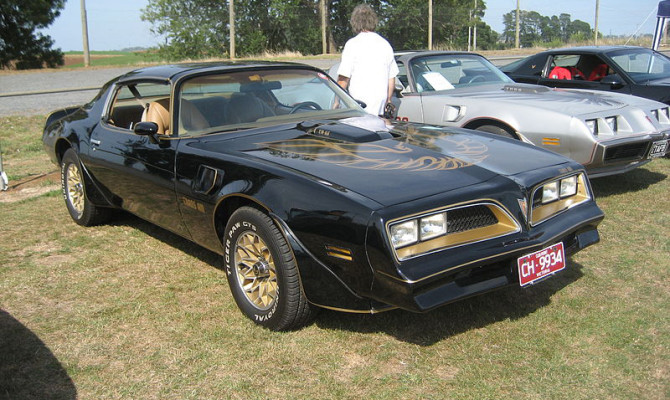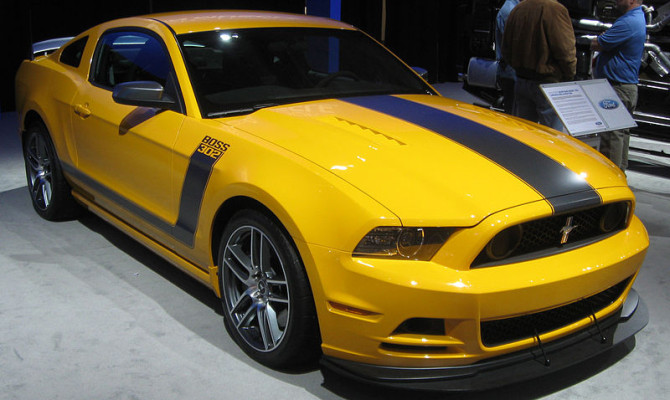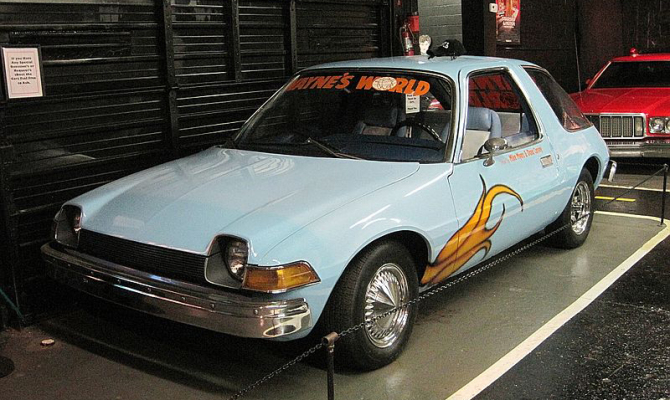by Grant Stoecker
The ‘Malaise Era’ was the antithesis of the muscle car heyday that existed merely a year before its start in 1973.
It was a dark period characterized best by underwhelming engines, EPA restrictions, and questionable styling. In the Malaise Era you could run your new Cobra through the gears without raising the attention of local law enforcement. The Malaise era wasn’t without hope, and the era saw production of a few diamonds in the rough. Here are our picks.
1. 1977 Pontiac Firebird Trans-Am Special Edition
Call it the Burt Reynolds Effect, but the 1977 Trans-Am is still a kick-ass ride. Featured in 1977’s top grossing film, Smokey and the Bandit, the black and gold Trans-Am had as much star power as the moustachioed Reynolds.
The power for the T/A came from a 6.6 litre V8, producing a disappointing 200 horses for 1977, a far cry years prior. It didn’t seem to matter as you cruised down main street, however, T-Tops in the trunk and blasting Journey through the 8-track. The menacing looks of the Trans Am seemed to be more than supple to erase any memory of the days of muscle car past, as other drivers stared in awe from the seats of the latest econo-box.
2. 1981-83 DeLorean DMC-12
The DMC-12 was the car from the future that no one had asked for, but everyone wanted.
Built by an automotive dream team consisting of John DeLorean, Colin Chapman, and Giorgetto Giugiaro, the DMC-12 was built to be a futuristic luxury coupe with a 200 horsepower Wankel rotary engine and price of $12,000. Execution of the concept missed the mark, and the production DMC-12 drew its underwhelming 130 horsepower from a Renault 6, and was sold for $36,000.
Despite this, the DeLorean secured its spot in the hearts of people around the globe as Doc Brown’s time machine in the 80’s mega-franchise, Back to the Future. If only they had come stock with the flux capacitor.
3. 1983-86 Audi Quattro
Germany continued to make fast cars throughout the malaise era, such as the BMW M1 and Porsche 930, but Audi created a completely new segment of car with the introduction of its all-wheel drive performance car, the Audi Quattro.
The Quattro was originally introduced to the European marketplace in 1980, but did not make its way stateside until 1983. With power from its turbocharged five-cylinder going to all four wheels, the Audi Quattro became a rally car legend, and the production models looked the part with its noticeable fender flares, Audi graphics, and BBS alloy wheels. The car was a head of its time, and only 664 were ever sold in the US before Audi discontinued it stateside in 1987.
4. 1974-76 Bricklin SV-1
Canada’s primary contribution to the malaise era was the brainchild of American millionaire Malcolm Bricklin, who dreamt of making the world’s safest sport car, naming his creation the Safety Vehicle One, or SV-1. The SV-1 had a smattering of safety features ranging from an integrated roll cage to safety bumpers, and even lacked an ashtray to discourage drivers from smoking. The Bricklin was powered by an AMC or Ford V8, and was rated favorably at the time against its competitor, the Corvette. Despite initial reviews, the car was notorious for poor build quality, and the engine was prone to overheating due to its small radiator. Bricklin went into receivership in 1976, and the SV-1 was dead in the water.
5. 1987 Buick Grand National/GNX
The Buick Grand National was not your grandfather’s Buick. Often referred to as Darth Vader’s car due to its all black paint scheme, the Buick Grand National was powered by a Turbocharged V6, and was rated for only 245 horsepower. The Grand National Experimental, or GNX, was the baddest of the Grand Nationals, and after rolling off the production line, it was sent to the mad scientists over at McLaren Performance, who modified the engine to be able to run 0 to 100 m/h in a mere 4.3 seconds, a figure impressive by modern standards.
Grant Stoecker writes for Hagerty Insurance. Hagerty is the world’s leading specialist provider of classic car and boat insurance. Learn more at hagerty.ca
by Grant Stoecker
Most 5- to 10-year-old cars are just used cars, destined to head steadily to the bottom of their depreciation curve as an intermediate stop on the way to their ultimate destination— the local pick-and-pull lot.
Here are five used cars that deserve a cushy spot in the Garage Mahal of a collector:
2009 Pontiac Solstice GXP coupe
Pontiac’s demise during GM’s bankruptcy was a sad story, and the loss of this fantastic sports car made it even more bitter. The Solstice roadster was an attractive car that suffered from terminal packaging problems. The Solstice coupe was drop-dead gorgeous and far more practical. Just 1,200 were built before GM did the equivalent of burning, pillaging and sowing salt in the field—they killed Pontiac, offed the Solstice and closed the Delaware plant in which it was built. Used coupes with normal miles have barely depreciated and low mileage cars are already appreciating.
2006 Chrysler Crossfire SRT6
The 2006 Crossfire SRT6 is undoubtedly the greatest lovechild of the affair between Chrysler and Mercedes-Benz in the early 2000s. While the standard Crossfire coupe and convertible where offered from 2004-2008, the SRT6 was only available in showrooms in 2005, and as a factory special order in 2006. This Chrysler/Benz mashup was essentially a Mercedes-Benz SLK32 AMG redressed as a hardtop coupe with breakneck performance, featuring a handcrafted AMG supercharged V-6 laying down 330 hp to the rear wheels. Hindsight is always 20/20, and the only regrettable decision in development of the car was to offer only the AMG signature automatic transmission, making it the only model in the Crossfire lineup not offered with a 5-speed manual. Fewer than 1,500 were produced, making this model quite rare.
2005-2011 Lotus Elise
While the Lotus Elise’s last model year technically was 2011, they still are being produced as a stopgap model until the 3rd generation model is released. Unfortunately, the Elise lost its smart airbag exemption stateside, meaning that the only Lotus available in North America is the all-too-luxurious Evora — it even has air-conditioning and power steering as standard equipment. On a Lotus! For those who still want to enjoy the ever-so-Spartan Elise, consider looking to the used car market. However, buyers might want to be wary of HPDE and track cars, as these have probably seen quite a bit of abuse — Elises with salvage titles are prevalent.
1999-2009 Honda S2000
Possibly the best enthusiast car produced under the Honda badge in the past decade, the S2000 served as a fitting tribute to the S-series roadsters of the 1960s. With its aggressive styling, a high-revving 4-cylinder engine producing 237 hp, an ultra-low center of gravity, and 50/50 weight distribution, an unmolested S2000 is bound to be a future collector car. However, due to the affordability of the S2000, many have suffered a cruel and all-too-usual punishment at the hands of the “Fast and Furious” generation. Serious collectors should look for the rarer Club Racer model, which saw limited production in 2007 only.
2012/2013 Ford Mustang Boss 302
This special edition of Ford’s ever-popular Mustang saw the return of the late ’60s and early ’70s Trans Am legend, the Boss 302. The Boss got its original name in the late ’60s when it was a skunk works project at Ford. Whenever asked what they were working on, members of the team simply responded “the boss’s car,” and the nomenclature stuck. The new generation features a retuned 5.0, putting out an additional 32 hp, and enough track day goodies to make any racing enthusiast giddy at even the slightest thought of it. In addition to the standard Boss, an additional Laguna Seca variant is available. The LS is a further upgrade with racecar parts, including a rear cross brace, and is limited to only 750 units per year. The Boss 302 was only produced for its scheduled two-year run, with just 4,000 models made each year, ensuring future collectability.
*Grant Stoecker writes for Hagerty Insurance. Hagerty is the world’s leading specialist provider of classic car and boat insurance. Learn more at hagerty.ca…
by Grant Stoecker
Driveway Canada
**********
Sequels are rarely as good as the first, but give this second round of clunkers from film and television a chance.
Each of the following cars was selected based on reader comments.
Uncle Buck, 1975 Mercury Marquis Brougham
We all have that oddball relative – if you can’t think of one, well, it’s probably you. In 1989’s hit comedy, Uncle Buck, John Candy portrays Uncle Buck, an unemployed gambler charged with caring for his wealthy suburbanite brother’s children. While the children might find Uncle Buck a bit odd, they find his ’75 Marquis downright revolting — and terrifying if standing anywhere near it when it backfires.
Columbo, 1959 Peugeot 403 Cabriolet
This popular television series starred Peter Falk as disheveled detective Lieutenant Columbo. While most cops would opt to drive a service car, Columbo chooses to drive his personal car, a faded Peugeot 403 Cabriolet that often suffers from mechanical problems at inopportune moments. And just one more thing: The car was personally selected for the show by Falk, after he spotted it in a parking lot at Universal Studios.
Wayne’s World, 1976 AMC Pacer
Ah, the “Mirth Mobile”! This 1976 Pacer was the ride of choice for public-access cable stars Wayne and Garth in 1992’s cult classic Wayne’s World. While the Mirth Mobile, with its mismatched wheels and flame decals, is sure to make any car lover go “schwing,” the Pacer is often noted for its unique styling, courtesy of the famous designer Richard Teague.
Harper, 1956 Porsche 356 Speedster
Who would have ever thought of Paul Newman driving a Porsche on the big screen? Sarcasm aside, Paul Newman’s eponymous character, Harper, is a wisecracking private investigator tasked with tracking down a kidnapped millionaire in the 1966 film of the same name. Harper’s decrepit Porsche 356 Speedster makes several appearances in the film, including a horrific tumble down a hill (at least for a Porsche-phile like myself). Fortunately it was not a true 356A Speedster, but a shell with exhaust tips attached.
Dude Where’s My Car, 1979 Renault Le Car
In 2000’s so-bad-it’s-funny comedy Dude, Where’s My Car, Ashton Kutcher and Seann William Scott wake up from an eventful night only to find they’ve forgotten where they parked their beat-up Renault Le Car. In an effort to find it, they encounter an unlikely group of UFO cultists, two races of aliens, and a universe-destroying Rubik’s Cube. After saving the universe from guaranteed destruction via the Rubik’s Cube, they discover that their car has been hidden behind a double-parked mail truck the entire time.
Content provided by Hagerty Insurance. Hagerty is the world’s leading specialist provider of classic car and boat insurance. Learn more at hagerty.ca.
Recent Comments
- { Enjoyed your Forest of Bowland in the BMW X5M, particularly the photo of the BMW in front of the main part of Stonyhurst College where... }
- { Bantam designed the Jeep, not Willy's or Ford. The American military gave the original Bantam prototype to Willys and Ford to copy. There is plenty... }
- { All Escalades come with a 6.2-lilter V8 engine that produces 420 horsepower. A six-speed automatic is the only transmission offered and drives the rear wheels.... }
- { Alexandra is an excellent journalist. }
Popular Posts
- Journey to a ‘Sparkling’ Luxury Okanagan Resort “Four lucky readers will put a Dodge Journey’s weekend-...
- The Need For Speed: Hike Those Highway Limits More than half of those polled believe the province sho...
- Drives-U-Crazy… Erratic drivers. An early morning drive from Kelowna to Vancouver is nor...
- Readers Respond: The Pros and Cons of Increasing B.C. Speed Limits Increasing the speed limits will only increase risk to...
- Honda CR-V Review: The Compact Crossover To Get Things Done The CRV is a very stylish and aerodynamic crossover veh...


















